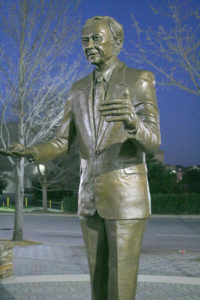The Peace Corps in the Time of Trump, Part 6
In the middle of 1989, Loret Ruppe left the Peace Corps to become a U.S. ambassador in Europe and Paul Coverdell was appointed Director on April 20. Once again the head of the agency became a revolving door.
All Directors, as we know, have a way of stamping their tour (however brief) with some new project. For Coverdell it was the famous school-to-school program and the establishment of the Fellows/USA which helps RPCVs get into graduate programs.
Coverdell would also say that the Peace Corps should be a “vibrant, vital part of the U.S. foreign policy.” This was a radical change for an organization that has embodied the spirit of altruism since its inception. The Peace Corps has always been about helping other people because it was the right thing to do, not because it was politically advantageous or even politically correct.
Coverdell, however, is most famous for a front page Washington Post article written by Al Kaman (Dominican Republic 1966-68) on January 2, 1991, where Al writes, “In his first 18 months as Peace Corps director, Paul D. Coverdell visited his hometown of Atlanta 19 times and appeared eight times in five other cities in Georgia during trips paid in full or in part by the government.
In addition, the Peace Corps paid part of Coverdell‘s travel either to or from Atlanta on five other trips during which he spent the weekend at his house there, according to travel records obtained by The Washington Post under the Freedom of Information Act.
In all, 26 of the 45 domestic trips Coverdell made as director in that period took him to Georgia at some point, prompting widespread speculation in the agency that the veteran Georgia politician intends to run for office in Georgia.
While Kamen used the Freedom of Information Act for the evidence of his travel history to Georgia, he was tipped off about Coverdell’s travel by an RPCV working at HQ. It is not surprising that the Deputy Director at the time, another political appointee, and former Congresswoman, would comment that the trouble with the Peace Corps was that “there are too many RPCVs working here.” You get the picture of these two.
Coverdell, of course, ran for the senate as a Republican from Georgia and was elected in November 1992 by a margin of 51 to 49 percent points. He had been able to use the good name of the Peace Corps and travel allowance to get him back to Georgia so that he could be elected to the U.S. Senate. However, these frequent flights did have another benefit. He met a flight attendant on one of his trips and they eventually married.
The final insult was when the Republican Congress—after Coverdell’s death–named the Peace Corps D.C. Headquarters building after him, and named only a ground floor conference room “Sargent Shriver Hall.”
Let’s hope that next year when the Peace Corps HQ is moved—as I am predicting it will—out beyond the Beltway,(where no RPCV will be able to find it) the name Coverdell will disappear from the agency’s address. Today it reads:
Paul D. Coverdell Peace Corps Headquarters
1111 20th St. NW Washington, DC 20526

Thanks, John. Perhaps NOW is the time for a campaign to have the new PC HQ named for Loret Miller Ruppe, whom everybody, politicians and RPCVs alike, can agree on. JAT
Name the building for Sarge and the conference hall for Loret.